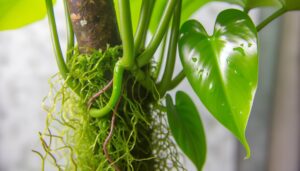What Soil Is Best for Philodendron Cordatum?
The perfect soil for Philodendron Cordatum consists of a well-rounded mix of peat moss, perlite, coconut coir, and pine bark fines. This combination enhances moisture retention, improves aeration, and provides essential organic matter.
Aeration is essential for root respiration, preventing compaction and root rot. The mix should maintain a slightly acidic to neutral pH to facilitate best nutrient uptake.
Regularly checking soil moisture and ensuring proper drainage are crucial to avoid waterlogging and support healthy growth. Utilizing this specific soil mix provides the foundation for thriving Philodendron Cordatum, while additional details can further enhance its care.
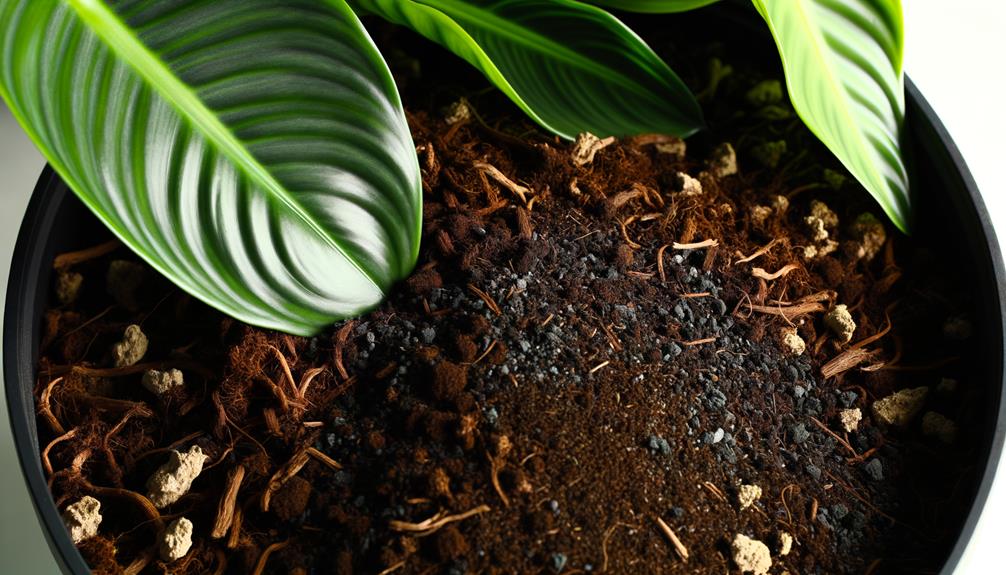
Key Takeaways
- Use a mix of peat moss, perlite, coconut coir, and pine bark fines for optimal growth.
- Ensure the soil has excellent drainage to prevent root rot and waterlogging.
- Maintain high humidity levels to mimic the plant's natural habitat.
- Regularly check and adjust soil pH to ensure proper nutrient uptake.
- Incorporate organic matter to enhance soil structure and nutrient content.
Natural Habitat
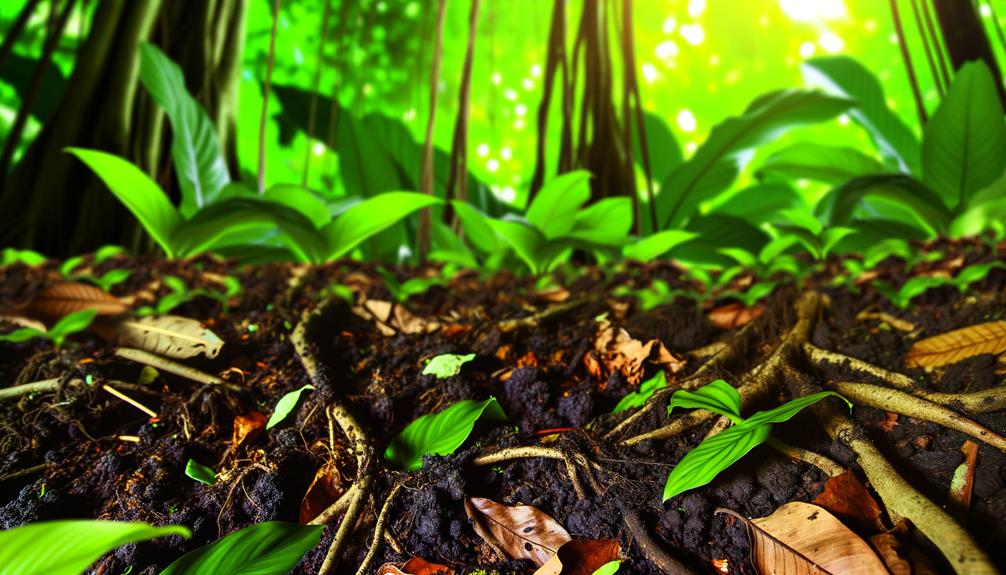
Philodendron cordatum, native to the tropical rainforests of Brazil, thrives in a humid environment with dappled sunlight and well-drained, nutrient-rich soil.
This epiphytic species typically grows under the forest canopy, where it benefits from indirect light that filters through the dense foliage above. The natural habitat provides high humidity, which is essential for prime growth, enabling the plant to maintain turgidity and facilitate nutrient uptake.
The soil in these regions is rich in organic matter, derived from decomposing leaf litter and other plant debris, contributing to its fertility. This nutrient-rich environment supports the philodendron's vigorous growth and lush foliage.
Understanding these natural conditions is crucial for replicating them in cultivation to sustain the plant's health and vigor.
Soil Drainage
Essential soil drainage is crucial for preventing root rot and ensuring the healthy growth of Philodendron cordatum. This species thrives in well-aerated substrates, which facilitate optimal water movement and oxygen availability to roots. A mixture of peat, perlite, and orchid bark often proves advantageous, enhancing drainage and mimicking the plant's natural epiphytic environment.
Observations indicate that poorly-drained soils lead to waterlogged conditions, suffocating roots and promoting fungal growth. Regularly checking the soil's moisture content and ensuring that excess water can escape through drainage holes is vital. Care guidelines recommend repotting every 1-2 years to maintain soil structure and prevent compaction.
Ph Levels
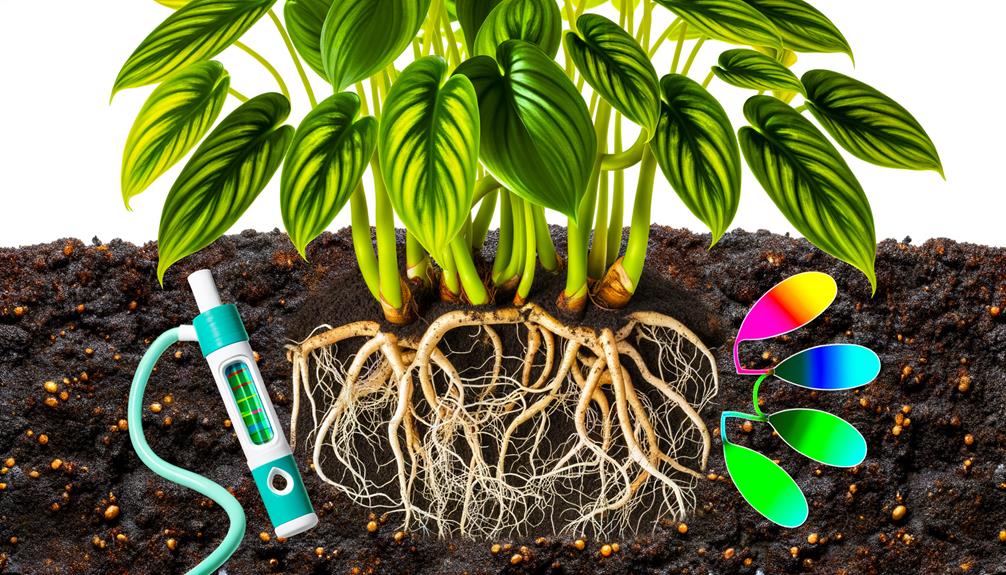
Maintaining an optimal pH level between 5.5 and 6.5 is necessary to guarantee the proper nutrient uptake and overall health of Philodendron cordatum. This slightly acidic range optimizes the availability of key nutrients such as nitrogen, phosphorus, and potassium, which are essential for robust growth and vibrant foliage. A pH level outside this range can lead to nutrient deficiencies or toxicities, inhibiting plant development.
To maintain the appropriate pH level, consider the following guidelines:
- Regular testing: Use a soil pH meter to monitor the pH level periodically.
- Soil adjustments: Utilize sulfur or lime to modify pH as needed.
- Water quality: Ensure the water used is not excessively alkaline or acidic.
- Balanced fertilization: Opt for fertilizers that are pH balanced.
Organic Matter
Incorporating organic material into the soil is necessary for enhancing its structure, nutrient content, and water-holding capacity, subsequently promoting the healthy growth of Philodendron cordatum. Organic material, such as compost, leaf mold, and peat moss, introduces essential nutrients and beneficial microorganisms that improve soil fertility. These amendments also facilitate moisture retention and drainage, creating an ideal environment for root development.
| Organic Material Type | Nutrient Contribution | Benefits to Soil Structure |
|---|---|---|
| Compost | High in nitrogen | Enhances aeration and drainage |
| Leaf Mold | Rich in humus | Improves water retention |
| Peat Moss | Acidic, contains tannins | Increases organic content |
Maintaining a balanced mix of these components ensures that Philodendron cordatum thrives, exhibiting robust foliage and vigorous growth.
Aeration
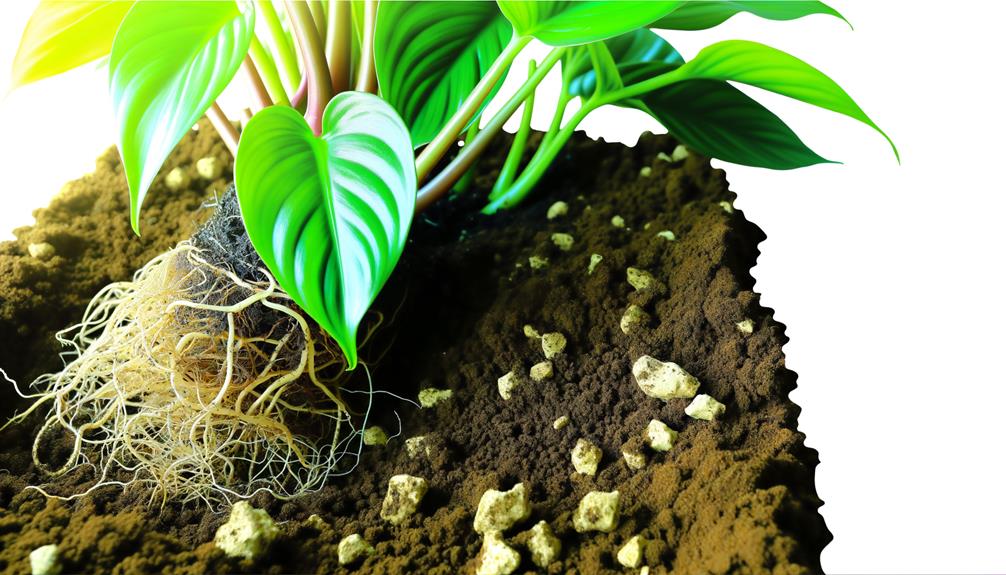
Aeration is crucial for the best growth of Philodendron cordatum, as it guarantees proper air flow within the soil matrix. This facilitates root respiration, promoting overall root health and vigor.
Additionally, well-aerated soil prevents compaction, which can impede water drainage and hinder nutrient uptake.
Proper Air Flow
Maintaining ideal air circulation within the soil medium is crucial for the healthy root development of Philodendron cordatum. Proper aeration prevents soil compaction, allowing roots to access oxygen and nutrients efficiently.
To achieve peak aeration, consider the following guidelines:
- Soil Components: Include perlite, orchid bark, or coarse sand to improve soil structure.
- Watering Practices: Avoid excessive watering to prevent waterlogging, which decreases air pockets within the soil.
- Container Choice: Opt for pots with sufficient drainage holes to support air circulation and prevent root rot.
- Soil Turnover: Regularly loosen the top layer of soil to uphold aeration and prevent crust formation.
These practices guarantee that the soil remains porous, encouraging strong root growth and overall plant health.
Root Health Benefits
Optimal soil aeration directly contributes to enhanced root health by facilitating oxygen exchange and nutrient absorption, thereby preventing root suffocation and promoting vigorous growth in Philodendron cordatum.
Well-aerated soil ensures that roots have access to essential oxygen, which is vital for cellular respiration and energy production. Enhanced aeration also allows for efficient nutrient uptake, supporting robust root development and overall plant vitality.
Observations indicate that Philodendron cordatum thrives in a soil mix incorporating components such as perlite, orchid bark, and peat moss, which promote ideal aeration. Care guidelines recommend maintaining a balance between moisture retention and air permeability to avoid root rot while ensuring sufficient airflow.
Consistent monitoring of soil conditions is essential for sustaining root health and plant growth.
Preventing Soil Compaction
Preventing soil compaction in Philodendron cordatum is crucial for maintaining ideal root aeration and promoting healthy plant growth. Soil compaction restricts oxygen availability and impedes water drainage, leading to root rot and diminished nutrient uptake.
To enhance soil aeration, consider the following guidelines:
- Incorporate Perlite or Pumice: These inorganic amendments enhance soil structure by increasing porosity.
- Use Coarse Bark: Adding coarse bark to the soil mix helps in maintaining air pockets around roots.
- Regularly Aerate Soil: Gently loosen the top layer of soil periodically to prevent surface compaction.
- Choose Well-Draining Potting Mixes: Opt for a mix specifically formulated for aroids, which typically includes ingredients like peat moss, perlite, and pine bark.
Implementing these strategies ensures optimal root health and robust plant development.
Moisture Retention
Effective moisture preservation is crucial for maintaining the health and vigor of Philodendron cordatum, as it secures a consistent supply of water to the plant's roots. Maintaining appropriate moisture levels ensures the plant's metabolic processes function at their best, facilitating nutrient uptake and growth. The soil's moisture retention capacity can be assessed using various indicators such as water-holding capacity, porosity, and texture. Below is a simple table to illustrate key components influencing moisture preservation:
| Component | Impact on Moisture Preservation |
|---|---|
| Organic Matter | Enhances water-holding ability |
| Soil Texture | Influences porosity and drainage speed |
| Mulch Application | Decreases evaporation |
| Watering Practices | Maintains consistent soil moisture |
Monitoring these factors can greatly enhance the cultivation conditions for Philodendron cordatum.
Recommended Soil Mix
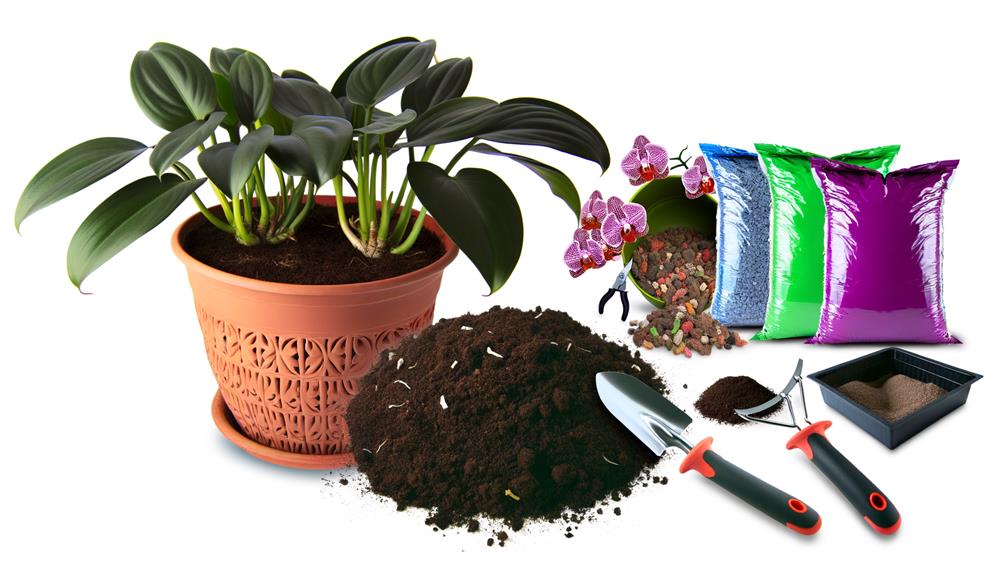
To maximize moisture retention and overall health of Philodendron cordatum, a well-balanced soil mix is crucial. Peak growth is achieved through a medium that promotes both aeration and moisture control.
Based on scientific observations and horticultural best practices, the recommended components for an ideal soil mix are:
- Peat Moss: Enhances moisture retention while contributing organic matter.
- Perlite: Improves aeration and prevents soil compaction, crucial for root health.
- Coconut Coir: Provides excellent water retention and drainage, reducing the risk of root rot.
- Pine Bark Fines: Adds structure to the mix, promoting better root growth and nutrient availability.
This mix ensures a harmonious environment, fostering strong growth and reducing potential issues related to overwatering or inadequate drainage.
Conclusion
To sum up, the ideal soil for Philodendron cordatum is a marvel of horticultural precision. It embodies exceptional drainage, slightly acidic pH levels, abundant organic matter, and superior aeration. This soil achieves a delicate balance, ensuring both moisture retention and root health.
A recommended mix comprising peat moss, perlite, and orchid bark not only replicates the plant's native conditions but also elevates its growth potential to extraordinary heights. This meticulous soil composition is essential for cultivating a thriving Philodendron cordatum.


